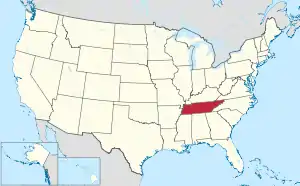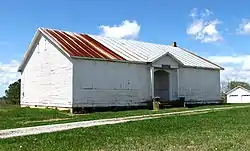Macon County, Tennessee
Macon County is a county located in the U.S. state of Tennessee As of the 2020 census, the population was 25,216.[2] Its county seat is Lafayette.[3] Macon County is part of the Nashville-Davidson–Murfreesboro–Franklin, TN Metropolitan Statistical Area.
Macon County | |
|---|---|
 Macon County Courthouse in Lafayette | |
 Seal | |
 Location within the U.S. state of Tennessee | |
 Tennessee's location within the U.S. | |
| Coordinates: 36°32′N 86°01′W | |
| Country | |
| State | |
| Founded | 1842 |
| Named for | Nathaniel Macon[1] |
| Seat | Lafayette |
| Largest city | Lafayette |
| Area | |
| • Total | 307 sq mi (800 km2) |
| • Land | 307 sq mi (800 km2) |
| • Water | 0.1 sq mi (0.3 km2) 0.03% |
| Population (2020) | |
| • Total | 25,216 |
| • Density | 72/sq mi (28/km2) |
| Time zone | UTC−6 (Central) |
| • Summer (DST) | UTC−5 (CDT) |
| Congressional district | 6th |
| Website | maconcountytn |
History

Macon County was formed in 1842 from parts of Smith and Sumner counties. It was named in honor of the late Revolutionary War veteran and United States Senator, Nathaniel Macon.[4] The county seat was named in honor of the Marquis de Lafayette.[1]
Unlike adjacent counties of Middle Tennessee, which were generally pro-Confederate, but like neighbouring counties in Kentucky,[5] Macon County was largely pro-Union during the Civil War. In Tennessee's Ordinance of Secession referendum on June 8, 1861, Macon County voted to remain in the Union by a margin of 697 to 447.[6] Macon was one of only eight counties in West or Middle Tennessee to support the Union. Earlier on February 9, 1861, Macon County voters had voted against holding a secession convention by a margin of 960 to 73.[7] Many Macon Countians served in Kentucky Union regiments, especially the Ninth Infantry Regiment, because secessionists in surrounding Tennessee counties drove them over the state line.[8]
The county's second-largest city, Red Boiling Springs, thrived as a mineral springs resort in the late 19th and early 20th centuries. Three hotels from this period — the Donoho Hotel, the Thomas House Hotel (previously the Cloyd Hotel), and the Armour's Hotel (previously the Counts Hotel) — are still open, though only the Armour's still offers mineral water treatments.
Geography
According to the U.S. Census Bureau, the county has a total area of 307 square miles (800 km2), of which 307 square miles (800 km2) is land and 0.1 square miles (0.26 km2) (0.03%) is water.[9] Macon County is located amidst the northeastern Highland Rim, and is generally rugged and hilly.
Adjacent counties
- Monroe County, Kentucky (northeast)
- Clay County (east)
- Jackson County (southeast)
- Smith County (south)
- Trousdale County (southwest)
- Sumner County (west)
- Allen County, Kentucky (northwest)
Demographics
| Census | Pop. | Note | %± |
|---|---|---|---|
| 1850 | 6,948 | — | |
| 1860 | 7,290 | 4.9% | |
| 1870 | 6,633 | −9.0% | |
| 1880 | 9,321 | 40.5% | |
| 1890 | 10,878 | 16.7% | |
| 1900 | 12,881 | 18.4% | |
| 1910 | 14,559 | 13.0% | |
| 1920 | 14,922 | 2.5% | |
| 1930 | 13,872 | −7.0% | |
| 1940 | 14,904 | 7.4% | |
| 1950 | 13,599 | −8.8% | |
| 1960 | 12,197 | −10.3% | |
| 1970 | 12,315 | 1.0% | |
| 1980 | 15,700 | 27.5% | |
| 1990 | 15,906 | 1.3% | |
| 2000 | 20,386 | 28.2% | |
| 2010 | 22,248 | 9.1% | |
| 2020 | 25,216 | 13.3% | |
| U.S. Decennial Census[10] 1790-1960[11] 1900-1990[12] 1990-2000[13] 2010-2014[2] | |||

2020 census
| Race | Number | Percentage |
|---|---|---|
| White (non-Hispanic) | 22,439 | 88.99% |
| Black or African American (non-Hispanic) | 120 | 0.48% |
| Native American | 60 | 0.24% |
| Asian | 44 | 0.17% |
| Pacific Islander | 8 | 0.03% |
| Other/Mixed | 861 | 3.41% |
| Hispanic or Latino | 1,684 | 6.68% |
As of the 2020 United States census, there were 25,216 people, 9,170 households, and 6,215 families residing in the county.
2010 census
At the 2010 census,[16] there were 22,248 people, 8,561 households, and 6,112 families living in the county. The population density was 72 people per square mile (28 people/km2). There were 9,861 housing units at an average density of 32 units per square mile (12/km2). The racial makeup of the county was 96.03% White, 0.42% Black or African American, 0.35% Native American, 0.20% Asian, 0.01% Pacific Islander, 1.96% from other races, and 1.04% from two or more races. 4.13% of the population were Hispanic or Latino of any race.
Of the 8,561 households 30.16% had children under the age of 18 living with them, 54.55% were married couples living together, 5.58% had a male householder with no wife present, 11.26% had a female householder with no husband present, and 28.61% were non-families. 24.27% of households were one person and 10.86% were one person aged 65 or older. The average household size was 2.57 and the average family size was 3.02.
The age distribution was 25.02% under the age of 18, 8.39% from 18 to 24, 31.59% from 25 to 44, 20.69% from 45 to 64, and 14.09% 65 or older. The median age was 38.7 years. For every 100 females, there were 97.08 males. For every 100 females age 18 and over, there were 95.21 males.
2000 census
At the 2000 census there were 20,386 people, 7,916 households, and 5,802 families living in the county. The population density was 66 people per square mile (25 people/km2). There were 8,894 housing units at an average density of 29 units per square mile (11/km2). The racial makeup of the county was 97.86% White, 0.22% Black or African American, 0.42% Native American, 0.24% Asian, 0.07% Pacific Islander, 0.77% from other races, and 0.44% from two or more races. 1.71% of the population were Hispanic or Latino of any race.[17] Of the 7,916 households 35.00% had children under the age of 18 living with them, 60.70% were married couples living together, 8.80% had a female householder with no husband present, and 26.70% were non-families. 23.80% of households were one person and 10.70% were one person aged 65 or older. The average household size was 2.55 and the average family size was 3.00.
The age distribution was 26.10% under the age of 18, 8.50% from 18 to 24, 29.40% from 25 to 44, 23.30% from 45 to 64, and 12.70% 65 or older. The median age was 36 years. For every 100 females, there were 97.40 males. For every 100 females age 18 and over, there were 95.10 males.
The median household income was $29,867 and the median family income was $37,577. Males had a median income of $28,170 versus $20,087 for females. The per capita income for the county was $15,286. About 11.30% of families and 15.10% of the population were below the poverty line, including 17.00% of those under age 18 and 25.40% of those age 65 or over.
Communities
Cities
- Lafayette (county seat)
- Red Boiling Springs
Unincorporated communities
- Beech Bottom
- Beech Hill
- Hillsdale
- Siloam
- Webbtown
- Willette
Transportation
Airport
Politics
| Year | Republican | Democratic | Third party | |||
|---|---|---|---|---|---|---|
| No. | % | No. | % | No. | % | |
| 2020 | 8,096 | 85.34% | 1,307 | 13.78% | 84 | 0.89% |
| 2016 | 6,263 | 83.46% | 1,072 | 14.29% | 169 | 2.25% |
| 2012 | 5,260 | 76.18% | 1,552 | 22.48% | 93 | 1.35% |
| 2008 | 5,145 | 69.90% | 2,060 | 27.99% | 155 | 2.11% |
| 2004 | 4,670 | 62.83% | 2,738 | 36.84% | 25 | 0.34% |
| 2000 | 3,366 | 51.86% | 3,059 | 47.13% | 66 | 1.02% |
| 1996 | 2,481 | 48.03% | 2,240 | 43.36% | 445 | 8.61% |
| 1992 | 2,299 | 40.15% | 2,961 | 51.71% | 466 | 8.14% |
| 1988 | 2,962 | 65.37% | 1,538 | 33.94% | 31 | 0.68% |
| 1984 | 3,330 | 65.23% | 1,747 | 34.22% | 28 | 0.55% |
| 1980 | 2,925 | 58.96% | 1,947 | 39.25% | 89 | 1.79% |
| 1976 | 2,063 | 50.93% | 1,951 | 48.16% | 37 | 0.91% |
| 1972 | 2,295 | 75.67% | 653 | 21.53% | 85 | 2.80% |
| 1968 | 2,173 | 58.04% | 530 | 14.16% | 1,041 | 27.80% |
| 1964 | 1,846 | 56.08% | 1,446 | 43.92% | 0 | 0.00% |
| 1960 | 2,829 | 74.80% | 915 | 24.19% | 38 | 1.00% |
| 1956 | 2,207 | 66.96% | 1,069 | 32.43% | 20 | 0.61% |
| 1952 | 2,602 | 69.20% | 1,158 | 30.80% | 0 | 0.00% |
| 1948 | 1,708 | 68.05% | 738 | 29.40% | 64 | 2.55% |
| 1944 | 2,322 | 76.26% | 701 | 23.02% | 22 | 0.72% |
| 1940 | 1,730 | 70.76% | 711 | 29.08% | 4 | 0.16% |
| 1936 | 1,402 | 61.22% | 876 | 38.25% | 12 | 0.52% |
| 1932 | 1,123 | 55.65% | 885 | 43.86% | 10 | 0.50% |
| 1928 | 1,937 | 82.22% | 419 | 17.78% | 0 | 0.00% |
| 1924 | 1,808 | 71.97% | 689 | 27.43% | 15 | 0.60% |
| 1920 | 3,208 | 75.02% | 1,066 | 24.93% | 2 | 0.05% |
| 1916 | 1,600 | 62.02% | 980 | 37.98% | 0 | 0.00% |
| 1912 | 1,251 | 56.05% | 787 | 35.26% | 194 | 8.69% |
Although part of the Middle Tennessee Grand Division, Macon County is geographically firmly a part of Kentucky's Pennyroyal Plateau and has much more historically in common with adjacent Bluegrass State counties like Monroe, Clinton and Cumberland, or with counties in East Tennessee. Those Pennyroyal counties were overwhelmingly opposed to secession,[5] and a large majority of residents fought their Civil War in Union blue rather than Confederate gray. Consequently, after the Civil War, Macon County became an isolated powerfully Republican County in then-Democratic Middle Tennessee. Since 1884, the only Democratic presidential candidate to carry Macon County has been Bill Clinton in 1992, when he had Tennessee Senator Al Gore – who lived in neighbouring Smith County as a child – as his running mate. In the 2000 election, Gore's local popularity was sufficient to give him the third-highest Democratic percentage of the past 132 years despite losing the state, but since then like all of Appalachia and surrounding regions the county has shown an extremely rapid trend to the Republican Party due to powerful opposition to the Democratic Party's liberal views on social issues.[19]
In other statewide elections, Macon County has shown a similar rapid Republican trend. It voted for a Democratic Senator as recently as the 2002 election, when Bob Clement defeated Lamar Alexander by a mere nineteen votes,[20] but for the last three senatorial elections the Democratic candidate has not obtained more than 22.09 percent of the county's vote. Although Phil Bredesen carried the county in both 2002 and 2006, he is the last Democratic gubernatorial candidate to top thirty percent.
County government officials
County commission members
- Phillip Snow
- Todd Gentry
- Scott Gammons
- Mike Jenkins
- Benton Bartley
- Charles (Chop) Porter
- Mchelle Phillips
- Justin Dyer
- Kenneth Witte
- Scott Cothron
- Tony Wix
- Michael Slayton
- Jeff Hughes
- Barry King
- Chad West
- Kyle Petty
- Wendell Jones
- Jarhea Wilmore
- Helen Hesson
- Marcus Smith
State and federal representation
Media
Newspapers
Television
Macon County is part of the Nashville media market. North Central Telephone Cooperative is the main cable television provider in the county.
References
- Martha Carver, "Macon County," Tennessee Encyclopedia of History and Culture. Retrieved: 11 March 2013.
- "State & County QuickFacts". United States Census Bureau. Archived from the original on June 7, 2011. Retrieved December 6, 2013.
- "Find a County". National Association of Counties. Retrieved June 7, 2011.
- Gannett, Henry (1905). The Origin of Certain Place Names in the United States. U.S. Government Printing Office. p. 195.
- Copeland, James E. (October 1973). "Where Were the Kentucky Unionists and Secessionists". The Register of the Kentucky Historical Society. 71 (4): 344–363.
- "Tennessee Secession Referendum, 1861". Vote Archive.
- "Tennessee Vote on Secession Convention, 1861". Fayetteville Observer. March 21, 1861.
- Noe, Kenneth W. (July 17, 2007). ""Battle Against the Traitors": Unionist Middle Tennesseeans in the Ninth Kentucky Infantry and What They Fought For". In Dollar, Kent; Whiteaker, Larry; Dickinson, W. Calvin (eds.). Sister States, Enemy States: The Civil War in Kentucky and Tennessee. University Press of Kentucky. pp. 125–129. ISBN 9780813125411.
- "2010 Census Gazetteer Files". United States Census Bureau. August 22, 2012. Retrieved April 9, 2015.
- "U.S. Decennial Census". United States Census Bureau. Retrieved April 9, 2015.
- "Historical Census Browser". University of Virginia Library. Retrieved April 9, 2015.
- Forstall, Richard L., ed. (March 27, 1995). "Population of Counties by Decennial Census: 1900 to 1990". United States Census Bureau. Retrieved April 9, 2015.
- "Census 2000 PHC-T-4. Ranking Tables for Counties: 1990 and 2000" (PDF). United States Census Bureau. April 2, 2001. Archived (PDF) from the original on October 9, 2022. Retrieved April 9, 2015.
- Based on 2000 census data
- "Explore Census Data". data.census.gov. Retrieved December 26, 2021.
- Bureau, U.S. Census. "U.S. Census website". United States Census Bureau. Retrieved March 11, 2018.
- "U.S. Census website". United States Census Bureau. Retrieved May 14, 2011.
- Leip, David. "Dave Leip's Atlas of U.S. Presidential Elections". uselectionatlas.org. Retrieved March 11, 2018.
- Cohn, Nate (April 24, 2014). "Demographic Shift: Southern Whites' Loyalty to G.O.P. Nearing That of Blacks to Democrats". New York Times.
- "2002 Senatorial General Election Results – Macon County, TN". Dave Leip’s U.S. Election Atlas.
- "County Mayor". www.maconcountytn.gov. Retrieved November 19, 2019.
- "Property Assessor". www.maconcountytn.gov.
- "Trustee". www.maconcountytn.gov.
- "Sheriff s Office". www.maconcountytn.gov.
- "County Clerk". www.maconcountytn.gov.
- "Register of Deeds". www.maconcountytn.gov.
- "County Commission". www.maconcountytn.gov.
- "Representatives - TN General Assembly". www.capitol.tn.gov. Retrieved November 19, 2019.
- "Senators - TN General Assembly". www.capitol.tn.gov. Retrieved November 19, 2019.
- "Our District". Representative John Rose. December 4, 2012. Retrieved November 19, 2019.
External links
- Official site
- Macon County Chamber of Commerce
- Tennessee Central Economic Alliance for Macon County
- Macon County at Curlie
- Macon County, TNGenWeb - free genealogy resources for the county